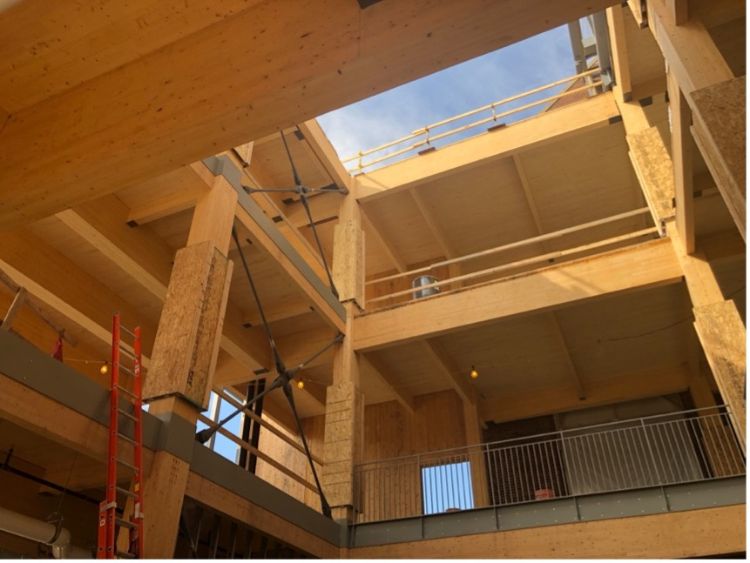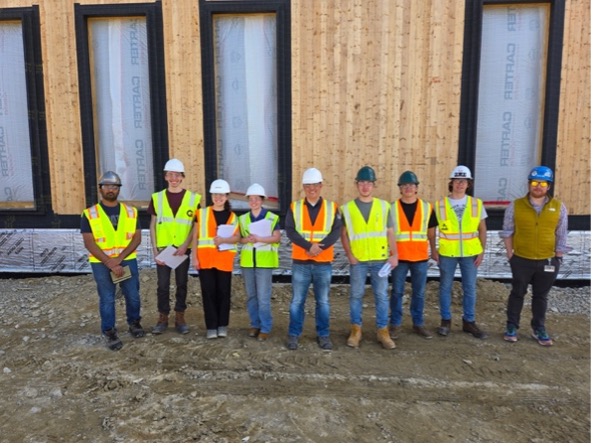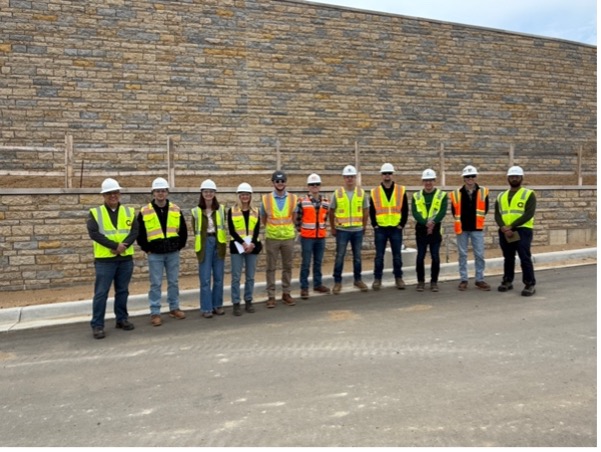Michigan State University Introduces New Mass Timber Construction Management Course – One of the First in the U.S.
MSU’s new mass timber course, one of the first taught from a construction management perspective, prepares students to lead sustainable building projects in a fast-growing industry.

EAST LANSING, MI — Mass timber is a rapidly growing topic within the construction industry, including in Michigan, where about 65 mass timber projects across the state are either complete or in the pipeline. Those buildings range from K-12 schools, universities, and training facilities to government buildings and even a hotel. And Michigan State University is home to the second building in Michigan to use Cross-Laminated Timber (CLT): the STEM Teaching & Learning Facility, completed in 2021.
MassTimber@MSU, fully launched that same year, leverages research, education, outreach, and policy to generate significant mass timber momentum in Michigan. The program, a collaboration across the Department of Forestry; School of Planning, Design, and Construction (SPDC); and MSU Extension, facilitates an activated mass timber community of practice comprising hundreds of Michigan professionals across a broad range of sectors – especially those in architecture, engineering and construction industries facing the learning curve of working on their first mass timber projects.
To equip MSU students to become mass timber MVPs for their future employers, MSU’s School of Planning, Design, and Construction this spring introduced a new course focused entirely on mass timber — one of the first in the country taught from a construction management perspective. The course was created and led by George Berghorn, Assistant Professor of Construction Management (SPDC) and Research Director of MassTimber@MSU, who, alongside other faculty and researchers, saw a significant gap in how mass timber is currently being taught.
“When we do find mass timber-related courses, they tend to be much more design focused,” Berghorn said. “We found virtually no programs with a construction management lens.”
Through a National Science Foundation-funded curriculum project, Berghorn and his team surveyed programs across the U.S. and saw that workforce education has repeatedly been cited as a barrier to mass timber adoption. That gap inspired the creation of this course, designed not only to fill a need in the market but to help future construction professionals keep pace with the industry's shift toward sustainable, innovative construction methods.
Why Michigan? Why MSU?
Michigan is quickly becoming a leader in the second wave of mass timber adoption, following the Pacific Northwest’s early momentum.
“We’re biased, but we really believe MSU has been on the leading edge of this movement,” said Sandra Lupien, Director, MassTimber@MSU. “Since 2018, we have actively worked with collaborators to create an ecosystem to support mass timber — from research and industry partnerships to actual buildings,” she said. “George’s course is a natural extension of that work and provides students to learn about mass timber from a uniquely qualified professor with a holistic perspective: George worked for 20 years in the construction industry, has several active mass timber research projects, and he also has a graduate degree in forestry.”
MassTimber@MSU serves as a hub that connects research, education, and industry. This new course builds on that foundation and gives students hands-on experiences, including site visits to Michigan mass timber projects and guest lectures by national industry leaders.
Inside the Course
Open to students across all disciplines, the Spring 2025 course attracted a group of 27 students from construction management to civil and environmental engineering.

The curriculum, organized into seven modules, covers topics across the full mass timber value chain:
- Mass timber materials and manufacturing
- Sustainability and carbon impacts
- Building codes and fire performance
- Construction management considerations
- Global case studies
- Supply chain logistics
- Hybrid construction strategies
“It’s not about memorizing facts — it’s about giving students the foundational knowledge to explore mass timber further,” said Berghorn. “We want curious students who are ready to innovate and think critically about the future of building.”
Field trips have included visits to mass timber buildings across Michigan, including the State of Michigan’s new state public health and environmental science laboratory in Dimondale. The new building, which incorporates cross-laminated timber, will provide laboratory space for various departments, including the Departments of Health and Human Services; Environment, Great Lakes, and Energy; Labor and Economic Opportunity; and Agriculture and Rural Development. The class also traveled to Kalamazoo to see the construction progress of the Kalamazoo Country Club’s new mass timber clubhouse.
The Department is currently exploring options to continue the course in future academic years, whether on campus or abroad.

Bridging the Gap Between Classroom and Industry
The course also features guest speakers from the mass timber industry, who share real-world insights on what’s happening in the field.
Guest speaker, Michaela Harms, Vice President of Mass Timber at manufacturer Sterling Structural, emphasized the importance of exposing students to practical challenges and emerging trends in construction.
“This course bridges the gap between academia and the real world,” Harms said. “It prepares students to work with architects, engineers, developers, and policymakers — people who are shaping the built environment in real time.”
Harms also noted that the mass timber industry is evolving quickly, from custom, high-end buildings to scalable, repeatable systems that will be used across the commercial market. For students, that means opportunities to lead and innovate are only growing.
Preparing Students for Real-World Impact
Feedback from students has been enthusiastic. Many say they feel they’re part of something new and exciting, and that they’re gaining knowledge that will set them apart in the job market.
MSU construction management alumni already working with mass timber have echoed that sentiment. Some wish they’d had a course like this when they were students.
“Whatever the industry shift is, it’s our responsibility to make sure students are prepared,” Berghorn said. “Mass timber is timely. It’s relevant. And it’s what the industry needs right now.”
Advice for Future Students
Berghorn’s advice for students or professionals interested in mass timber? Stay curious.
“Be a lifelong learner,” he said. “Reach out to professionals. Ask questions. Don’t be afraid to put yourself out there — this is not a moment to be shy.”
The mass timber momentum is growing, and MassTimber@MSU is helping to lead the way.



 Print
Print Email
Email

